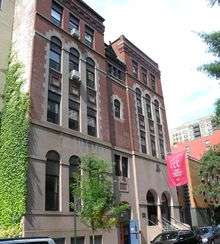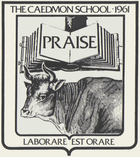Caedmon School
The Caedmon School is an independent coeducational elementary school located on the Upper East Side of Manhattan in New York City. The school, which employs a modified Montessori curriculum, was the first Montessori school established in New York City and the second in the United States.
| The Caedmon School | |
|---|---|
 | |
| Address | |
416 East 80th Street, New York, NY 10075 , , | |
| Information | |
| Type | Independent, Coeducational |
| Established | 1962 |
| Head of School | Matthew Stuart |
| Faculty | approx. 75 |
| Grades | Preschool through 5th Grade |
| Enrollment | 215 |
| Campus | Urban |
| Accreditation | Association of Independent Schools of New England American Montessori Society |
| Tuition | $18,687 - $31,438 (2012-2013) |
| Affiliation | NAIS, AISNE, AMS, MSM, IMC |
| Website | www.caedmonschool.org |
Founded in 1962, the school currently has approximately 255 students enrolled from Nursery through the Fifth grade.
The school
The school is located in a large townhouse on East 80th Street between First Avenue and York Avenue on the Upper East Side. The school employs a curriculum based on four foundational concepts: community, diversity, Montessori and academic excellence. With a faculty of over 40, the student to teacher ratio is approximately 6:1 overall. Class sizes range from 16-20 students and with two teachers per class in early grades.
The Caedmon School operates mixed aged classes from children as young as 3 through the second grade. Kindergarten and Third through Fifth Grade are dedicated to a single age group. Following graduation from Caedmon, the school's fifth grade students attend some of New York's best college preparatory schools.[1] In recent years, Caedmon students have moved on to a variety of schools including: Allen-Stevenson, Brearley, Browning, Chapin, Collegiate, Columbia Prep, Dalton, Horace Mann, Nightingale-Bamford and Spence.[1]
The following are Caedmon's six age-based educational programs across pre-school and elementary school:
- Beginners (younger than 3)
- Early Program (age 3-4)
- Elementary (Kindergarten through 5th Grade)
Tuition at Caedmon for the 2012-2013 school year range from $18,687 per year for the youngest Beginner class to $31,438 per year for the elementary school program.[2]
Other programs
In addition to its core academic activities, Caedmon also provides a number of additional programs including Special Club Activities, Afterschool activities, Childminding, and a well regarded Music Program.
Each summer, the school also hosts the Caedmon Discovery Camp. The six-week program provides an educational summer experience built on the same core principles as the schools academic program.
History

At the time that The Caedmon School was founded in 1962, Montessori education was undergoing its second rise in popularity in the United States. In the late 1950s Nancy Rambusch, who had undergone Montessori training in London, returned to the US with the idea of reviving Montessori education. Rambusch first founded the Whitby School in Greenwich, Connecticut, which became the flagship school of the American Montessori.[3] In 1960, Rambusch founded the American Montessori Society (AMS).[3]


By the fall of 1961, a group of ten families in New York City who had attended Rambusch's talks began planning a school. Like Whitby in Connecticut, Caedmon was conceived as a lay Catholic school, but a school that would also be attractive to a diverse community of differing religions.[4] Certain of the families had conflicting goals on certain issues, including the location for the school and the inclusion of religious instruction. A number of these families decided to separate to found their own school, which would later become the West Side Montessori School. The families that remained were to become Caedmon's founding trustees: Marilou and William Doyle; Elizabeth and Vincent Connelly; Joyce and Daniel Flynn; Nellie and Thomas Mahoney; and Robert Hurley. The Caedmon School would be the first Montessori school established in New York City.[4] At that time, Caedmon was the second Montessori school in the United States.
In 1969, Josephine Hartog, assumed the position of head of school which she held until 1974. She was succeeded by Nancy Rambusch who led the school throughout the late 1970s.[5] Rambusch who had been instrumental in the reintroduction of Montessori schools in the US by adapting the program to better fit American educational culture, had a strong influence on the development of Caedmon. Also in the 1970s, Caedmon created what was, at the time, the first extended-day activities program among independent schools in Manhattan.
Carol Gose DeVine was who had joined Caedmon in 1970 was named the Head of School in 1979. She held that position until 2007, making her one of the longest-serving heads of an independent school in the New York area.[6]
In the fall of 1994, Caedmon approached interested families for help in establishing a fund to support diversity at the school.
In 2002, the National Association of Independent Schools' Leading Edge Recognition program recognized Caedmon with its Curriculum Innovation award.[7] In 2005, the school opened a new gymnasium and science facility.
During the 2012-2013 school year, Caedmon celebrated the 50th anniversary of its founding.
The "Caedmon" name
The school was named after Cædmon, the earliest of all recorded English poets. The founders of Caedmon decided to select a name that paid tribute to The Whitby School, the first Montessori school in the US, which had served as an inspiration for the Caedmon School. The poet Cædmon was well known to have been buried in the English town of Whitby, after which the Whitby School had itself been named.
Curriculum
.jpg)
Caedmon's curriculum utilizes a modified Montessori approach and reflects the highest standards of the most competitive independent schools. A key components of the Montessori method is the classroom environment, which is highly prepared and allows for self-directed, independent learning. Students learn effective work-study skills in an environment that encourages independence, self-guided learning and responsibility.
At each stage, the curriculum and instruction takes into account the preparation for the next stage in the children's education. In the Elementary Program, students have exposure to the major curricular areas: language arts (i.e., reading, writing, spelling, handwriting), math and social studies.
Caedmon's curriculum is expanded and enriched by regular instruction in art, computer, foreign language, library, music, science, and physical education (including yoga), which are taught by specialists outside the classroom.
References
- "Caedmon School Placement information". Archived from the original on 2013-09-01. Retrieved 2013-03-27.
- "Caedmon School tuition information". Archived from the original on 2012-11-21. Retrieved 2013-03-27.
- Education: The Joy of Learning. Time, May. 12, 1961
- American Montessori Society Records: History Archived 2010-06-12 at the Wayback Machine. 2007
- Nancy Rambusch, 67, Educator Who Backed Montessori Schools. New York Times, October 30, 1994
- Carol Gose DeVine bio
- Profiles of Excellence in Independent Education. National Association of Independent Schools
- Being Exclusive Draws Big Crowds; Private Schools Enjoy a Boom, But Demand Exceeds Growth. New York Times, October 15, 1999
- Blackboard: Wonderland II. New York Times, January 7, 1990
- A 'Multinational' School Celebrating Differences Of Multinational Kids. New York Times, February 16, 1994
- Dr. Blackburn Tribute. School Tube
| Wikimedia Commons has media related to Caedmon School. |